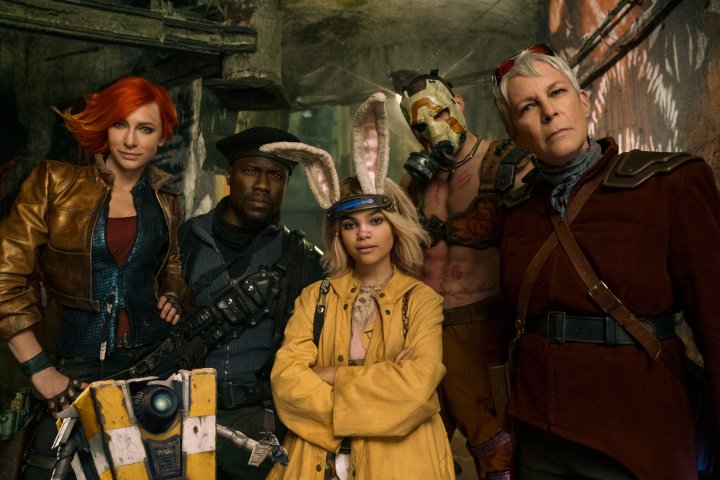Before its feature film adaptation, Borderlands was strictly a video game franchise. The role-playing game does not skimp on the action, as players can embark on high-speed quests, loot from the rich Vaults on Pandora, and utilize a variety of intricate weapons. The challenge of adapting a video game into a movie revolves around stunts. How can action from video games transfer over into a functional setting?
That’s where stunt coordinators come in. Borderlands’ feature film adaptation had two excellent stunt coordinators on hand: Jimmy O’Dee and Noon Orsatti. The duo are seasoned veterans in the stunt community, with experience in all kinds of movies, from Marvel and John Wick to Extraction and The Dark Knight. O’Dee and Orsatti believe using practical effects as much as possible can lead to a better final product.
In an interview with Digital Trends, O’Dee and Orsatti spoke about the challenges of bringing the game to life in the movie, the emphasis on practical effects, and the pressure to deliver a faithful adaptation to the video game community.
Note: This interview has been edited for length and clarity.

Borderlands takes stunts from a video game and applies them to a movie. How do you take a grounded approach and apply it to a film like Borderlands, which is based on a video game?
Jimmy O’Dee: Yeah, that’s interesting. When I first came on the project, one of the things I do, as my process, is write CVs for each of the characters. Like their resumes. What did they do in the past? How do they get to this position we find them in the film? So Lilith, I’d look about where she was born, [and] what was her training. Then looking at the game, what her skills were, and how we could make that look as believable as you’re going to see on the screen.
Basically, for me, it starts with finding out who they’ve fought, and what skills they have. What I tried to do was give them all [the characters] different fighting styles based on the history I found out about them through the games. When we come to do it, the first rule with Eli Roth is let’s just try and make it real. Then we’ll add all the magic that the gamers are expecting.

Noon Orsatti: The big advantage for me was having Eli as the director. He was very hip on all the savvy, new technology. In our initial meeting, which was held at a restaurant, he put a pair of VR goggles on me. It really gave me a sense of the land, the geography, and everything about the look of the movie, which gave me a heads up of “Oh boy. I better do a little bit of research on this thing.” I did my homework and watched some videos. I YouTubed Borderlands and got to know the characters.
In terms of bringing it into real life, that’s where I come from. I come from a land of the real. Everything that we did on the ground was practical. We had real cars. We had real people. We had real jumps and real obstacles to overcome, all within the knowledge and perspective of the world that is going to be created around this.
It was a little tricky where you want to shoot something and, you really want the car to come zooming close to the camera, but we realize we want to accentuate that there’s a beast on the right side of the frame. You know, that kind of thing. It takes a little bit of finessing and understanding the overall geography of the scenes. That was really most helpful to me when I got those VR goggles on and started to realize there’s got to be a lot of space between a couple of these moving cars. It was a little challenging for me, but fun.

We’re seeing a lot of stunt coordinators and stunt people become good directors — Chad Stahelski, David Leitch, etc. From your perspective, why do you think this transition from stunt work to directing is happening so seamlessly?
O’Dee: I know Dave and Chad well. I worked with Dave a lot. I’m so pleased for them both because they are great ambassadors for that transition. Charlton Heston once said that if every department was as efficient as the stunt department, a film would take a third of the time to make. I think that’s true because stunt coordinators and second-unit directors look at the details. When you’re trying to sell an idea and when you’re doing an action sequence, you’re writing what was written on the page, so you’ve got to sell that emotion at the moment through physical action. You’ve got to feel the emotion of the actor who is in trouble.
It’s all these little details that you look at that translate beautifully to directing. You look at Dave’s films and Chad’s films, the detail they have is phenomenal. You’ve also got J.J. Perry doing it now. Sam Hargrave. There are a few guys making the transition. I directed a short last year, and I hope to direct a main unit [feature film] soon. Fingers crossed. Certainly, when you look at that, they’ve made a great transition. I think it’s because of their attention to detail that they look at everything and every aspect of it.

Orsatti: I think that the stunt community has been an unheralded faction of this amazing universe of filmmaking for a long time. I’ve been in this [stunt community] all my life, so I’ve been able to see the transition. Chad Stahelski used to work for me, Dave Leitch used to work for me, and Sam Hargrave used to work for me. [laughs] All along, you can see the genius of these guys. They’re editing tirelessly. They are creating, within the realm of the movie, action that suits the movie that tells the story.
It’s no longer “Punch. Punch. Jump. Jump. Fireburn.” We’re all trying to integrate the action that really is part of the movie and that tells the story. Instead of hellacious big gags, it’s now big gags that seamlessly coincide perfectly with the movie.
I believe that the guys that are really taking the torch, so to speak, and running ahead, are saying, “You know, we can direct. And not only can we direct, we can tell the story in action.” They’ve [Asian stunt community] been doing it a long time with Hong Kong films, and they let the action be part of the overall flow of the movie. I believe that’s the answer.
We really started to focus on the storytelling parts of action. That’s why it’s happening. Wisdom would tell a production that this is a good way to go. Hey, they can do it all, and why not? There are some brilliant minds in the stunt industry. It’s crazy.
Where do you think the state of stunts is today? There’s always the debate about which movies are using practical effects and which are using computer-generated images. Where do you think the industry is going?
O’Dee: It’s interesting. You get a lot of the audience, and I’m a film fan, who loves watching movies. I want to watch as many movies as I can. I love the movies where I can’t quite tell how they [stunt coordinators] did it straight away. I’m like, “Oh, OK. That’s interesting.” We’re in a state where the CGI is so good. It means you can do a fight scene with a stunt performer, and you can put the face on [of the actor] without even knowing it, which is great. Also, you’ve got situations now where you can put actors in apparent danger more than you possibly could before. Some of our equipment is safer than it was before, so it means you can actually have them very high up.
I’ve said it many times in interviews. People don’t pay to see stunt doubles. They pay to see the actors that they care about in the story [and] in jeopardy. That’s what you’re trying to get across in the written word. Where stunts are now, certainly for the way I do it, I’ll always try and do practical first. You go to production meetings, and the producer says, “Well, we can’t afford that. What else can you do?” CG sometimes gives us a happy medium. For example, working at height. The practicality of shooting on a 400-foot building is tricky, so you could do a second unit that could do some wide shots with the stunt double. Then, you can mix.
Now, the safety equipment is good that you can actually put actors up there for certain key shots, which is going to sell the movie. I think now, certain audiences don’t buy that that’s a cartoon. You ultimately know if something is CG or not. I was watching a film the other day, which I won’t mention, [laughs] because it was a good movie. I lost interest because I went, “Oh, this part is all CG.” I didn’t mean to lose interest. I just picked up my phone and started doing this [mimic cell phone scroll]. All my colleagues that I speak to, we all try and do it for real as much as we can. I think that’s how it’s always going to go. I don’t think people will be happy with just CG.
Orsatti: I was just recently a part of a Marvel movie that we walked away from CG almost altogether. We went right back to practical gags, and it was a very stunt-heavy movie. I would think that this is the trend. It’s money-saving. It’s time-saving. It’s turnover-saving. They can get a movie out much faster. There’s not a boatload of CG. Based on what I’m seeing lately, I do believe that the industry is changing, and it may be reverting back to the good old days, with a much more evolved sense of filmmaking.

Honestly, I would love to see it. I mean, why not? There are a lot of talented people out there who are not using all of their skill sets because of the CG world. I love CG. It’s part of the evolution of film. In terms of being an action man, I see it [reliance on practical over CG] happening much more frequently now.
Borderlands is now in theaters.




